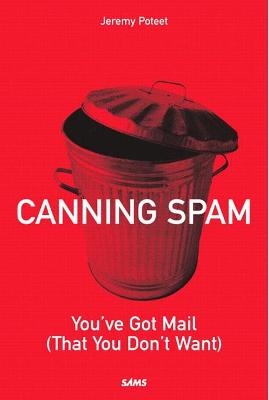
Canning Spam
Sams Publishing (Verlag)
978-0-672-32639-4 (ISBN)
We've all seen it — the e-mails that come to us from a sender we don't know and promise a frog that jumps across our screen, a low mortgage rate or a medical miracle pill. These e-mails are otherwise known as spam. Your inbox gets cluttered or worse, your computer is infected with a virus as you scratch your head, wondering how it ever happened. Now there is a way to stop the madness! Canning Spam: You've Got Mail (That You Don't Want) is your remedy to inbox clutter and infected computers. Learn how spammers get your e-mail address and how to stop them, how viruses are transmitted through attachments, how spammers can mask their true identity and how to ultimately block unwanted e-mails. Next time you log in to your e-mail account, be happy to hear those three little words: “You've Got Mail!”
Jeremy Potee is the Chief Security Officer for appDefense, a consulting company specializing in application security. Jeremy has many years of experience administering Windows, Unix and Linux-based servers. He is a Certified Information Systems Security Professional (CISSP) and was the winner in the 2002 eWeek OpenLabs OpenHack IV competition. Jeremy is an active member of the Open Web Application Security Project (OWASP), including serving as a project manager for the OWASP Guide and a monthly columnist on .NET security. He is also a member of multiple OASIS technical committees that establish security standards. He can be reached at CanningSpam@appdefense.com.
Introduction.
1. Stealing Candy from a Baby: How Spammers Harvest Email Addresses.
2. Neither Confirm Nor Deny: How Email Attacks Determine that an Email Address is Active.
3. Bad Things Come in Small Packages: How Viruses are Transmitted Through Email Attachments.
4. Using Email Clients for Good and Evil: Guarding Against Script-Based Viruses and Worms.
5. Would the Real Sender Please Stand Up?: How Spammers Spoof Email Identities.
6. Unwilling Accomplices?: How Spammers Mask their Identities using Email Relaying.
7. Separating the Wheat from the Chaff: Using Filters to Block Unwanted Emails.
8. Don't Send us a Postcard: Insuring that your Email is not Sent in the Clear.
9. You've Got Some Email in my Web Site: Using Web-based Email Services Securely.
10. The Bigger they are, the Harder they Fall: Mitigating Denial of Email Services Attacks.
Appendix A. Email Protocols.
Appendix B. Popular Email Tools.
Appendix C. Email Legal Information.
| Erscheint lt. Verlag | 27.5.2004 |
|---|---|
| Verlagsort | Indianapolis |
| Sprache | englisch |
| Maße | 152 x 228 mm |
| Gewicht | 339 g |
| Themenwelt | Informatik ► Netzwerke ► Mail Server |
| Sozialwissenschaften ► Kommunikation / Medien ► Journalistik | |
| Wirtschaft | |
| ISBN-10 | 0-672-32639-6 / 0672326396 |
| ISBN-13 | 978-0-672-32639-4 / 9780672326394 |
| Zustand | Neuware |
| Haben Sie eine Frage zum Produkt? |
aus dem Bereich

